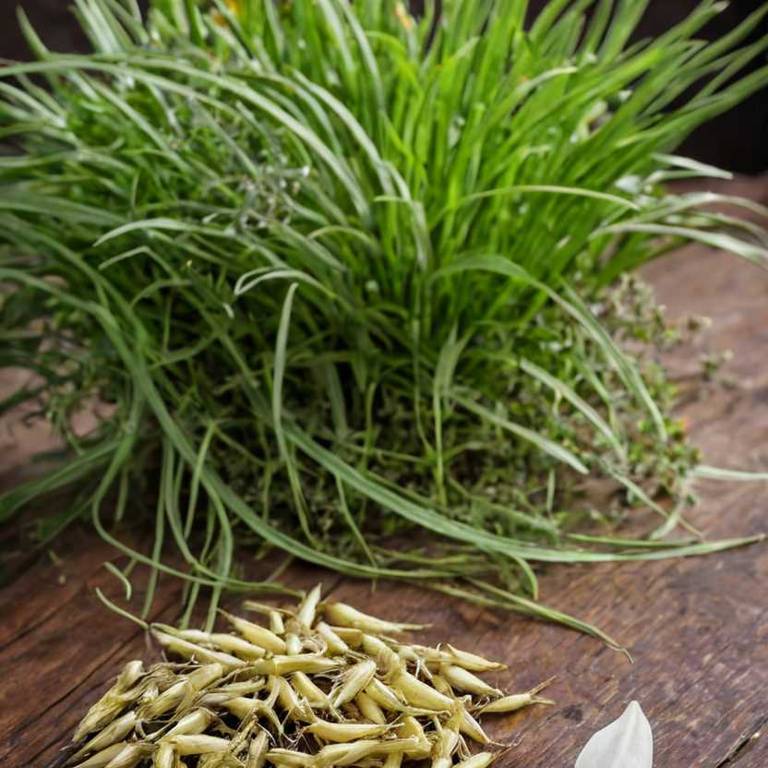10 Best Anemarrhena Asphodeloides Health Benefits

Anemarrhena asphodeloides, also known as Chinese anemarrhena, is a traditional Chinese medicinal herb known for its various health benefits.
It is commonly used to support respiratory health by helping to alleviate symptoms of coughs and bronchitis due to its expectorant properties. This herb is also valued for its ability to reduce fever and treat conditions such as malaria and inflammation. Anemarrhena asphodeloides is rich in alkaloids and has been shown to possess antimicrobial and antipyretic effects.
Additionally, it may help regulate blood sugar levels and support overall immune function, making it a valuable component in traditional herbal medicine.
1. Reduces inflammation
Anemarrhena asphodeloides reduces inflammation by inhibiting the production of pro-inflammatory cytokines and mediators in the body.
This herb has been shown to modulate the activity of immune cells, such as macrophages and T-cells, which play a key role in the inflammatory response. Its bioactive compounds, including saponins and alkaloids, contribute to its anti-inflammatory effects by suppressing the activation of inflammatory pathways. Clinical and experimental studies suggest that anemarrhena asphodeloides may be beneficial in treating conditions like arthritis and inflammatory bowel disease.
Overall, its anti-inflammatory properties make it a valuable herbal remedy in traditional and modern medicine.
2. Boosts immune system
Anemarrhena asphodeloides boosts immune system by containing bioactive compounds that enhance the body's defense mechanisms.
This herb is known to stimulate the production of white blood cells, which are essential for fighting off infections and diseases. Its anti-inflammatory and antioxidant properties further support immune function by reducing oxidative stress and inflammation in the body. Regular use of anemarrhena asphodeloides may help improve overall resistance to common illnesses.
As a result, it is often used in traditional medicine to promote health and resilience against pathogens.
3. Improves digestion
Anemarrhena asphodeloides improves digestion by promoting the secretion of digestive enzymes and enhancing gastrointestinal motility.
It helps in the breakdown of food and the absorption of nutrients, which can alleviate common digestive issues such as bloating and indigestion. This herb is known to support the healthy function of the stomach and intestines, making it beneficial for individuals with sluggish digestion. Its anti-inflammatory properties may also reduce irritation in the digestive tract, contributing to overall digestive wellness.
As a result, anemarrhena asphodeloides is often used in traditional medicine to support digestive health and improve the efficiency of the digestive system.
4. Supports liver health
Anemarrhena asphodeloides supports liver health by promoting detoxification and reducing inflammation within the liver tissue.
This traditional Chinese herb contains bioactive compounds that help protect liver cells from oxidative stress and damage. It may also enhance the liver’s ability to metabolize toxins and regenerate damaged tissues. Its anti-inflammatory and antioxidant properties contribute to overall liver function improvement.
Regular use of anemarrhena asphodeloides may aid in managing liver conditions such as hepatitis and fatty liver disease.
5. Promotes skin health
Anemarrhena asphodeloides promotes skin health by supporting the body's natural detoxification processes, which can lead to clearer and healthier skin.
Its anti-inflammatory properties help reduce redness and irritation, making it beneficial for individuals with sensitive or acne-prone skin. The herb also aids in balancing internal bodily functions, which can indirectly improve skin condition and texture. Additionally, it may help in reducing the appearance of blemishes and promoting a more even skin tone.
Overall, anemarrhena asphodeloides offers a holistic approach to enhancing skin vitality and appearance.
6. Lowers blood sugar
Anemarrhena asphodeloides lowers blood sugar by enhancing insulin sensitivity and promoting glucose uptake in cells.
This herb contains bioactive compounds that may help regulate blood glucose levels, making it beneficial for individuals with diabetes. Studies suggest that it can reduce postprandial glucose spikes, contributing to better glycemic control. Its traditional use in Chinese medicine aligns with modern research on its hypoglycemic effects.
Incorporating anemarrhena asphodeloides into a balanced diet may support overall metabolic health.
7. Reduces oxidative stress
Anemarrhena asphodeloides reduces oxidative stress by enhancing the body's antioxidant defense system.
This herb contains bioactive compounds that help neutralize free radicals, which are known to cause cellular damage. By scavenging reactive oxygen species, it protects cells from oxidative damage and supports overall health. Its antioxidant properties may contribute to the prevention of chronic diseases linked to oxidative stress.
Regular use of anemarrhena asphodeloides can therefore promote a balanced internal environment and improve longevity.
8. Enhances respiratory health
Anemarrhena asphodeloides enhances respiratory health by reducing inflammation in the airways and promoting the clearance of mucus.
This herb is known to support the body's natural ability to fight off respiratory infections and improve lung function. Its active compounds may help alleviate symptoms such as coughing, shortness of breath, and bronchial irritation. It is often used in traditional medicine to treat conditions like asthma and chronic bronchitis.
Regular use of anemarrhena asphodeloides may contribute to overall respiratory wellness and improved breathing.
9. Aids in detoxification
Anemarrhena asphodeloides aids in detoxification by supporting the body's natural processes to eliminate harmful substances.
This herb is known to enhance liver function, which plays a crucial role in filtering toxins from the bloodstream. It also promotes the excretion of waste products through the kidneys, further aiding the body's cleansing mechanisms. The plant contains compounds that may help neutralize free radicals and reduce oxidative stress, contributing to overall detoxification.
Regular use of anemarrhena asphodeloides can support long-term health by maintaining the efficiency of the body's detox systems.
10. Improves sleep quality
Anemarrhena asphodeloides improves sleep quality by promoting relaxation and reducing anxiety, which are common contributors to insomnia.
This herb contains compounds that may help regulate the nervous system, leading to deeper and more restful sleep. It is often used in traditional medicine to alleviate symptoms of sleep disturbances and enhance overall sleep duration. The calming effects of anemarrhena asphodeloides can help individuals fall asleep more easily and stay asleep throughout the night.
As a result, it supports better mental and physical recovery, making it a valuable natural remedy for improving sleep quality.